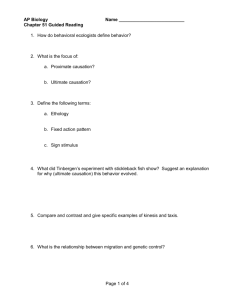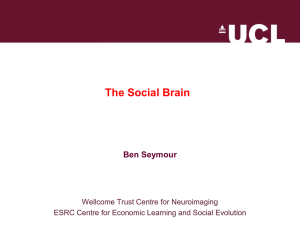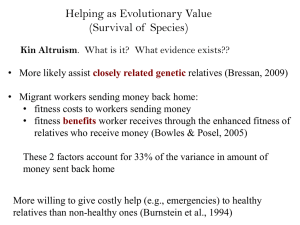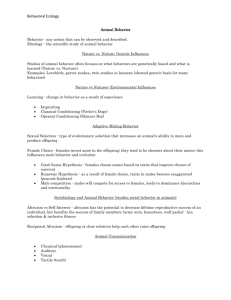9.916 Altruism and Cooperation
advertisement
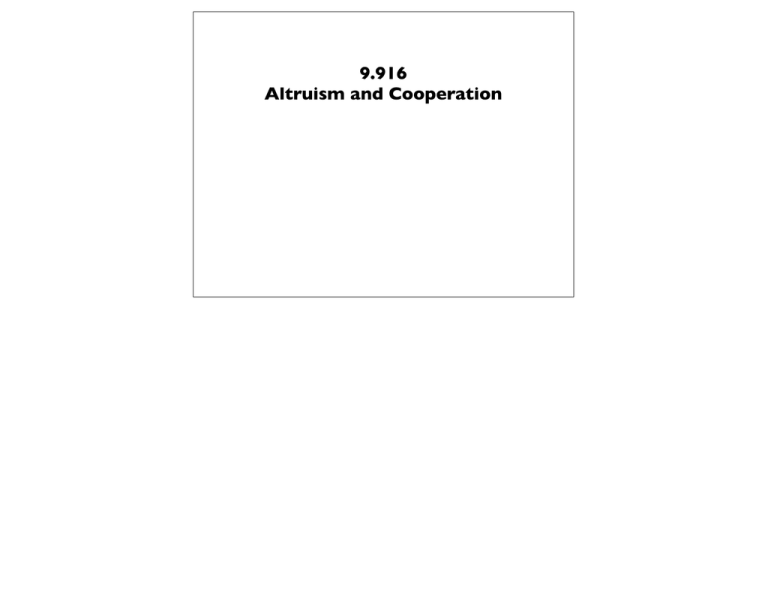
9.916 Altruism and Cooperation Today’s Lecture I give everyone $10 Anonymous pairs Chance to send $0-$10 Anything you send, x3 How much do you send? Puzzle of altruism: How could it evolve? free-riders should out-compete altruists “the central theoretical problem of sociobiology” Puzzles of human altruism: Why is human behavior cooperative / altruistic? (a) developmental origins: genetic or learned? (b) how maintained in practice? (c) what proximal mechanisms? Altruism & Cooperation Coordination: joint effort Cooperation: joint effort Altruism: joint effort Nash equilibrium = cooperate or defect maximum collective & individual payoff no/less payoff for defection Nash equilibrium = defect maximum collective/other’s payoff higher individual payoff for defection Nash equilibrium = defect increase other’s payoff cost to individual Altruism Games What makes a “game”? Each P’s payoff depends on the actions of other Ps What makes an “altruism game”? Nash equilibrium is anti-social - give minimum - accept minimum - don’t punish Human behaviour is pro-social - give more than minimum - refuse minimum - punish But not perfectly! Often don’t achieve: - equal split - maximum collective payoff Altruism in 2 Player Games Dictator (1) P1 $10 ? P2 altruism / fairness Altruism in 2 Player Games Dictator (1) P1 $10 Ultimatum (1) P1 $10 ? ? P2 P2 altruism / fairness anticipated rejection (2) Accept / Reject fairness 2p punishment Altruism in 2 Player Games Dictator (1) P1 $10 Ultimatum (1) Trust P1 $10 (1) P1 $10 ? ? ? x3 trustingness P2 P2 (2) Accept / Reject P2 (2) P2 ? P1 trustworthiness fairness Altruism in 2 Player Games Dictator (1) P1 $10 Ultimatum (1) Trust Gift P1 $10 ? ? ? x3 ? (1) P1 $10 x3 (1) P1 $10 P2 P2 (2) Accept / Reject P2 (2) P2 P2 altruism / fairness ? P1 Altruism in 2 Player Games Dictator (1) P1 $10 Ultimatum (1) Trust Gift PD P1 $10 ? ? P2 P2 ? P2 x3 ? (1) P1 $10 P2 x3 ? (1) P1 $10 P2 x3 ? (2) P2 $10 P1 x3 (1) P1 $10 (2) Accept / Reject (2) P2 cooperation ? P1 Core Dilemma of Cooperation Standard Solution: Positive assortment Cooperators benefit other cooperators Natural selection for cooperation Benefit of receiving cooperation Probablity of benefiting cooperator βb > c favours cooperating: - closely related - long future - low noise - quantifiable exchange Cost to cooperator r - probability of sharing cooperation by descent ω - probability of continuing interaction ϕ - probablity of accurate reputation Henrich & Henrich 2007 Core Dilemma of Cooperation Standard Solution: Positive assortment Cooperators benefit other cooperators Natural selection for cooperation favours cooperating: - closely related - long future - low noise - quantifiable exchange Note 1: Simulations - Axelrod’s (1980) computer tournaments - repeated prisoner’s dilemma - round 1: 14 entries - round 2: 62 entries - round 3: ecological simulation - winner: tit-for-tat cooperates first, then tit-for-tat Example 1: cleaner fish Core Dilemma of Cooperation Standard Solution: Positive assortment Cooperators benefit other cooperators Natural selection for cooperation favours cooperating: - closely related - long future - low noise - quantifiable exchange Note 1: Simulations - Axelrod’s (1980) computer tournaments - repeated prisoner’s dilemma - round 1: 14 entries - round 2: 62 entries - round 3: ecological simulation - winner: tit-for-tat cooperates first, then tit-for-tat Axelrod 1984 / 2006 Example 2: Cooperation in the trenches Core Dilemma of Cooperation Example 2: Cooperation in the trenches Small battallions, stationary trenches -> Long futures, quantifiable exchanges Step 1: Recognise common interest in silence Step 2: Be provokable; show that the silence is deliberate Step 3: Damping? Axelrod 1984 / 2006 Step 4: Passing info along Core Dilemma of Cooperation Standard Solution: Positive assortment Cooperators benefit other cooperators Natural selection for cooperation Note 1: Simulations - Axelrod’s (1980) computer tournaments - repeated prisoner’s dilemma - round 1: 14 entries - round 2: 62 entries - round 3: ecological simulation - winner: tit-for-tat cooperates first, then tit-for-tat Axelrod 1984 / 2006 favours cooperating: - closely related - long future - low noise - quantifiable exchange Special case? - dyadic - long future - no noise - quantifiable exchange Core Dilemma of Cooperation Standard Solution: Positive assortment Cooperators benefit other cooperators Natural selection for cooperation favours cooperating: - closely related - long future - low noise - quantifiable exchange Note 2: Entomological assumptions: Natural selection ≠ Genes Reliable transmission, fitness difference Individual learning Social learning Behaviour determined by genes Transmission by genes Invasion by reproductive success + Behavioural plasticity Lehnmann 2008 Core Dilemma of Cooperation Standard Solution: Positive assortment Cooperators benefit other cooperators Natural selection for cooperation favours cooperating: - closely related - long future - low noise - quantifiable exchange Note 3: Standard games: - no kinship - no future - no reputation “misfiring” mechanisms? Overestimate kin? Overestimate future? Feel observed? e.g. by the experimenter Who would you ask for a high cost favour? Creating Cooperation Internal mechanisms: Cooperate when visible - induce reciprocal cooperation - avoid punishment - create & protect reputation Cooperate responsively Cooperate conditionally Cooperate when needed - motivated to reciprocate - strong reciprocity norm - inequity aversion / empathy Cooperate pre-emptively Cooperate unconditionally - prosociality: motivated to help, no expectation of punishment or reward Creating Cooperation Look for: - different bw children & chimps - early emerging - culturally universal Transmission: Genetic? Cultural? Look for: - similar bw children & chimps - late emerging - culturally variable Internal mechanisms: - induce reciprocal cooperation - avoid punishment - create & protect reputation - motivated to reciprocate - strong reciprocity norm - inequity aversion / empathy - prosociality: motivated to help, no expectation of punishment or reward Prosociality Chimps coordinate for goals: Adjacent room Adjacent room 75 50 25 Test room Door & Key Food platform Door & Key 100 0 Near Far Session 1 Session 2 100 Courtesy Elsevier, Inc., http://www.sciencedirect.com. Used with permission. Stay 60 40 20 0 Melis et al 2006 Shift 80 Mean % of trials Depends on history with partner: Win Lose Figure by MIT OpenCourseWare. Prosociality Children coordinate for its own sake Figures removed due to copyright restriction. 50 25 Role B Role A Toddler 75 Level of engagement 75 0 High 100 Mean percentage of hits Mean percentage of hits 100 50 25 Medium Low No success 0 Double tube Double tube Role A Role B Chimp Toddler Figure by MIT OpenCourseWare. Warneken et al 2006 Inequity aversion No-cost Dictator “Game”: Figures removed due to copyright restrictions. Chimp Chimp Child 100 1 0.8 0.7 0.7 0.6 0.6 0.5 0.5 0.4 0.4 0.3 0.3 0.2 0.1 0.1 0 Percentage of egalitarian choices Pull other reward (mean proportion + SE) 0.9 0.2 1 2 3 Session 4 5 0 0 1 2 Number of 1/1 choices by partner in previous 2 trails 1/1 Vonk et al 2008, Brosnan et al 2009, Fehr et al 2009 1/0 or NR 80 60 40 20 0 3-4 5-6 7-8 Age Prosocial game: (1, 1) versus (1, 0) Figure by MIT OpenCourseWare. Inequity aversion Figure removed due to copyright restriction. Altruism / Cooperation Late emerging But 2p requires inhibition What about 3p? Fehr et al 2008 Creating Cooperation Internal mechanisms: Transmission: Cultural? Genetic? - induce reciprocal cooperation - avoid punishment - create & protect reputation Some evidence for - similar bw children & chimps - late emerging - culturally variable - motivated to reciprocate - strong reciprocity norm - inequity aversion / empathy Some evidence for - different bw children & chimps - early emerging - culturally universal - prosociality: motivated to help, no expectation of punishment or reward Maintaining Altruism with Punishment MIT OpenCourseWare http://ocw.mit.edu 9.916 Special Topics: Social Animals Fall 2009 For information about citing these materials or our Terms of Use, visit: http://ocw.mit.edu/terms.

